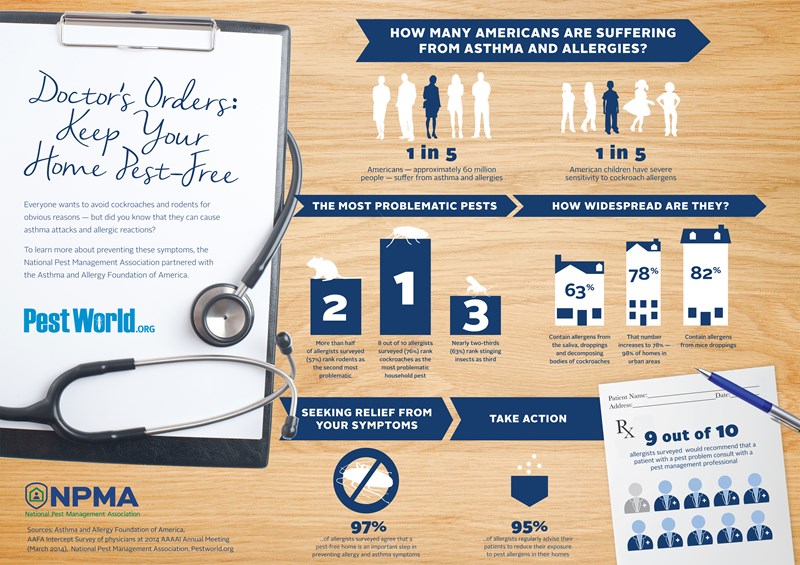READY TO GET STARTED?
REQUEST A FREE ESTIMATE
Fill out the form below or call (888) 466-7849 for a free, no-obligation estimate.
Each year, the Asthma and Allergy Foundation of America designates May as National Asthma and Allergy Awareness Month, an ideal time to educate the public about triggers, prevention and treatment measures for asthma and allergic diseases. In recognition of this important observation, we want to remind people that a few simple pest prevention measures can go a long way in combating allergies and asthma this spring.
Common household pests, such as cockroaches and stinging insects, can pose a significant threat to asthma and allergy sufferers. Cockroach droppings, saliva, shed skins and other body parts contain allergen proteins known to cause allergy flare-ups and increase asthma symptoms, especially in children. In addition, stinging insects send more than 500,000 people to the emergency room each year due to serious reactions from the pest’s venom.
Many people blame their sneezing and runny noses during the spring season on pollen and grass, however, household pests are often culprits as well. It’s important for people to make an effort to keep the home free of potential triggers, and the first step is practicing good sanitation.
The National Pest Management Association (NPMA) recommends the following tips for safeguarding homes against common indoor allergens caused by pests:

To view full image click HERE
Source: NPMA
 Ladybugs Seek Warmth in Homes
Ladybugs Seek Warmth in HomesLadybugs are beneficial insects but when they overwinter in your home they become a nuisance pest. They spend the warmer months of spring and summer growing their populations and like other overwintering pests, they seek warmth from the cold temperatures in fall and winter. Many seek shelter under rocks, leaves, or other items found in nature, then you have those that find shelter in homes and buildings.
Although typically harmless, ladybugs can aggravate asthma and cause allergic reactions in people. They can also emit a foul smelling, yellowish fluid that can stain surfaces.
Keeping ladybugs out of your home starts with the usual preventative pest management steps that we typically cover in our blogs: screen all windows, keep doors closed, door sweeps on exterior doors, and seal all cracks and crevices around the exterior of the home (windows, doors, pipes, etc).
If ladybugs have already found their way into your home, use a vacuum cleaner to clean them up. Empty the vacuum bag into a trash bag and make sure it is tightly closed. Discard of the trash bag in a sealed outside container. If you have a ladybug infestation, call a professional pest control company to evaluate, assess, and treat the problem. Call Northwest Exterminating for more on ladybug pest control.
PestWorld.org and The Asthma and Allergy Foundation of America have teamed up for a public service announcement to warn homeowner’s of the dangers of allergens in the home caused by pests and rodents. Common household pests such as cockroaches and mice are responsible for inciting allergies and aggravating asthma. In fact, 63% of homes contain cockroach allergens. That number increases to 78%-98% in urban areas. 82% of homes have asthma triggers spread by mice.
Watch NPMA’s public service announcement below:
Keep your family (children are especially at risk) and home safe by keeping your home pest free, call Northwest Exterminating. For more information visit pestworld.org or The Asthma and Allergy Foundation of America.
The NPMA will donate $1 to The AAFA for each new Facebook LIKE (HERE) until Sept, 15th. Go LIKE them…and LIKE Northwest Exterminating (HERE) while you’re there!
PestWorld.org and The Asthma and Allergy Foundation of America have teamed up for a public service announcement to warn homeowner’s of the dangers of allergens in the home caused by pests and rodents. Common household pests such as cockroaches and mice are responsible for inciting allergies and aggravating asthma. In fact, 63% of homes contain cockroach allergens. That number increases to 78%-98% in urban areas. 82% of homes have asthma triggers spread by mice.
Watch NPMA’s public service announcement below:
Keep your family (children are especially at risk) and home safe by keeping your home pest free, call Northwest Exterminating. For more information visit pestworld.org or The Asthma and Allergy Foundation of America.
The NPMA will donate $1 to The AAFA for each new Facebook LIKE (HERE) until Sept, 15th. Go LIKE them…and LIKE Northwest Exterminating (HERE) while you’re there!
SOURCE
Now that it’s pollen season, many people are suffering sneezing, coughing and discomfort due to an allergy to different pollen types. Though many people know that this triggers allergies within them, they may not know that various household pests can also contribute to allergies. Additionally, those who have asthma may suffer to pests such as cockroaches or mice being in home because these pests can spread strong asthma triggers.
PestWorld.org provides facts about pests and asthma, as well as a ‘First Responder PSA’ that highlights the risk that household pests can put us at when we are indoors. For instance, 63% of American homes contain allergens from cockroaches, but if the home is located in an urban area, it can even reach 98%! Additionally, mice can spread asthma triggers found in 82% of homes. According to the Asthma and Allergy Foundation of America, patients with cockroach allergies develop acute asthma attacks after inhaling cockroach allergens. Allergens can come from not only the actual body of the pest, but also its saliva and feces.
If you are experiencing minor symptoms such as, the AAFA recommends the use of antihistamines, decongestants and anti-inflammatory medications. An effective means to reduce the chance of exposure to pest allergens is using regular treatment through a pest control company. Northwest Exterminating offers services that eliminates and reduces the occurrence of a wide array of household pests including mice and cockroaches.
Sources:
http://www.pestworld.org/multimedia-center/first-responder-psa/